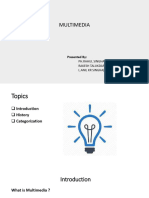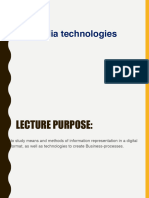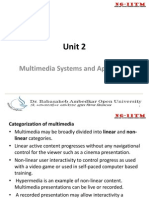0% found this document useful (0 votes)
88 views29 pagesIntroduction To Multimedia
Multimedia involves combining different media types such as text, audio, images, video, and interactivity. It provides advantages over traditional media by engaging multiple senses at once. A multimedia presentation typically includes text to convey information, audio such as narration or music, still images, videos, and interactivity for user input. Multimedia has applications in education, advertising, and entertainment by enhancing engagement and learning compared to text alone.
Uploaded by
Baimona S. GayanandangCopyright
© © All Rights Reserved
We take content rights seriously. If you suspect this is your content, claim it here.
Available Formats
Download as PDF, TXT or read online on Scribd
0% found this document useful (0 votes)
88 views29 pagesIntroduction To Multimedia
Multimedia involves combining different media types such as text, audio, images, video, and interactivity. It provides advantages over traditional media by engaging multiple senses at once. A multimedia presentation typically includes text to convey information, audio such as narration or music, still images, videos, and interactivity for user input. Multimedia has applications in education, advertising, and entertainment by enhancing engagement and learning compared to text alone.
Uploaded by
Baimona S. GayanandangCopyright
© © All Rights Reserved
We take content rights seriously. If you suspect this is your content, claim it here.
Available Formats
Download as PDF, TXT or read online on Scribd
/ 29


























































